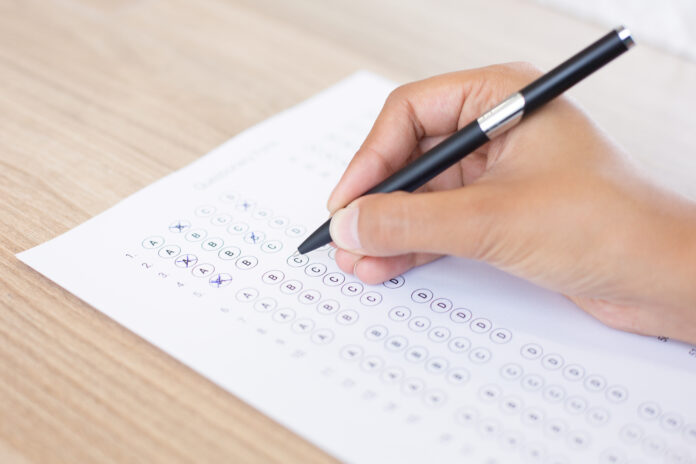By Nadra Nittle/Originally published by The 19th
College-bound students will soon get the chance to experience the SAT like never before. For the first time in the United States, the standardized test will be offered solely in digital form starting March 9. It will also be shorter and adaptive — meaning that the difficulty of the test questions in each section depends on student performance at the outset.
Over the past year, more than 220,000 students have taken the new digital test internationally, according to the College Board, the not-for-profit organization that developed the SAT. Eighty-four percent of students and 99 percent of staff said they prefer the digital SAT to the pencil-and-paper version, a College Board spokesperson told The 19th in a statement.
“The digital SAT is a better, more flexible test that’s easier to take, easier to give, more secure and more relevant,” the spokesperson said.
The SAT’s makeover is ushering in a new era for the college entrance examination first conceived about a century ago and widely administered by the 1950s. When the COVID-19 crisis began, however, higher education institutions across the country went test optional, threatening to render it passé. Now, the updates to the exam and the fact that elite colleges — including Yale, Dartmouth and the Massachusetts Institute of Technology — have reinstated standardized test scores in admissions are sparking debate about the SAT’s pros and cons.
“It is definitely more consumer-friendly and was designed to try and recapture market share that had been lost to the test optional movement,” said Bob Schaeffer, public education director of advocacy group FairTest: National Center for Fair & Open Testing. “It is shorter. The reading passages are … all much briefer, so less boring. It’s based on a computer, so you get your score very quickly, rather than waiting weeks for it.”
But, Schaeffer added, “That doesn’t make it a better test.”
Critics of the SAT say that changes to the assessment are unlikely to close its long-running gender gap, with girls scoring lower on the test than boys. Economically disadvantaged students, youth of color and those with learning differences have also historically underperformed on the exam. Additionally, the SAT’s detractors argue that it does not accurately predict how well students, especially young women, do in college. This casts doubt, they say, on the wisdom of requiring it for higher education, where young women make up just under 60 percent of students.
SAT supporters, in contrast, say the new version of the test has some advantages. The shorter length may benefit some students with learning differences, for example. That it is adaptive may lessen test-taking anxiety and that it is digital may help level the playing field in math because all students will access the same built-in online calculator. Using it in admissions, moreover, may offer a competitive edge to students from underrepresented groups who excel on it.
What the test’s proponents and opponents agree on is until the new test makes its domestic debut and the data starts to roll in, it’s unclear whether the new SAT will be a game-changer or more of the same for the nearly 2 million students who take it annually.
The Case for the New SAT
When Allen Koh first learned that the SAT was going digital, he was concerned about how the change would affect the students he serves. Koh is CEO of the Silicon Valley-based consulting firm Cardinal Education, which provides tutoring, test prep and admissions support to students, large numbers of whom are vying for entry into elite colleges and universities. Since his clientele spans five continents — Africa, Asia, Europe, North America and South America — many have already had the opportunity to take the updated version.
The SAT is now about an hour briefer, a boon to students with shorter attention spans, Koh said.
“Students who have learning differences, many of them, they’re absolutely loving the brevity of the SAT now,” Koh said.
By providing extensive documentation, students with learning differences such as ADHD or dyslexia may receive more time to take the exam. Such accommodations aren’t new, but Koh said that since the test used to be three hours, extra time for atypical learners led the process to stretch up to two days.
“It was exhausting,” he said. “Now, even students with learning differences, all of them can finish it in one day,” he said.
Diana Heldfond, CEO of Parallel Learning, which provides special education support for school districts in 15 states, knows what it’s like for the SAT to become a weekend-long experience. She has ADHD and dyslexia and took the SAT over two days when she was in high school a decade ago. She pointed out that students can qualify for a range of accommodations, though it’s a task that takes diligence.
“Once the students do have those accommodations, it can look very different,” Heldfond said. “Some students might get 25 percent extra time, some kids might get time-and-a-half, some might get double time. For the kids who have time-and-a-half or double time, it gets spread out already over such a long period of time that the standard protocol is actually to break it up into two days. It makes it even harder to find a testing center that will actually accommodate that. It becomes a much scarier test when all of a sudden instead of taking up three hours of your weekend, it’s actually your entire weekend.”
The greatest benefit of the updated SAT, Heldfond said, is the adaptivity. It offers a personalized testing experience that will likely put at ease students with learning differences, she said, though she noted that some youth in this population might prefer the predictability of the paper exam in which all test-takers answer the same questions.
Initially, Koh feared that the adaptive format would be more stressful for his clients, but he’s found that it has actually boosted their confidence. This is especially true for students who aren’t trying to enter highly competitive institutions, he said. The adaptiveness of the test also cuts down on anxiety, he added.
“If you start getting some questions wrong, then the adaptive testing will make it so that some of the brutally hard questions that break your morale don’t show up,” he said.
But the updated SAT’s biggest breakthrough, Koh contends, is that all test-takers will use the same built-in calculator. With the paper test, students had to bring their own calculators and inevitably mishaps would occur — from the devices running out of batteries to students simply forgetting to bring them, he said. Some students could not afford the calculators at all, as an advanced model can cost $100 or more.
Heldfond said that the calculator is particularly helpful for kids with math-related disabilities such as dyscalculia because they can practice with it online before taking the real test. Many students with learning differences perform better when they can minimize surprises, she said, and the online calculator helps them to do so.
“Now everyone’s got that calculator as part of their SAT, so that is one thing that, absolutely for equity, that’s just fantastic,” Koh said.
Concern that the SAT isn’t equitable has prompted a backlash against it in recent years. Maintaining a pandemic trend, more than 80 percent of the nation’s four-year colleges and universities will not require the SAT or its rival, the ACT, for fall 2025 admission, according to FairTest. But the announcements this year that top institutions will reinstate the SAT in admissions has drawn attention to the potential drawbacks of excluding standardized test scores from college applications.
Danielle Holley, president of Mount Holyoke College and former dean of Howard University Law School, told The 19th that high SAT scores give socioeconomically disadvantaged students an admissions edge. Since most schools are test optional now, college officials have to use other criteria to admit students. Often, the alternate factors considered are the rigor of a student’s high school or extracurricular activities, she said.
“Unfortunately, those things, as studies have shown, tend to favor privileged students — students who have the opportunity to hire a college admissions coordinator or coach who can help them to present themselves in the best way or is able to tell them what kind of extracurriculars pay off the most,” Holley said. “Without test scores, sometimes it actually reinforces privilege, because it allows the process to become more subjective, and more subjectivity lends itself to people who know what a college admissions officer wants to read.”
A College Board spokesperson told The 19th that test scores can demonstrate students’ strengths beyond their high school academic record. The spokesperson said that, in the class of 2023, about 1.3 million students in the United States earned SAT scores that aligned with or were better than their high school grade point average (GPA).
“That means that their SAT scores were a point of strength on their college applications,” the spokesperson said. “Among those 1.3 million students, nearly 440,000 were African American and Latino, more than 350,000 were first-generation college goers, and more than 250,000 were from small towns and rural communities. These numbers represent nearly 80 percent of each of these populations and remain very stable over time.”
When the test optional movement took off during the COVID-19 crisis, Koh recommended that his clients continue taking the SAT. That’s because, in an effort to stand out, students applying to top universities kept submitting their scores.
By not taking the test, underprivileged students who might have crushed the exam robbed themselves of scholarship money and admission to elite universities, he said. High test scores might sway an admissions officer to take a chance on a first-generation college applicant from a low-performing high school.
“If you’re a first-gen kid, if you’re low- or even middle-income, you need as many opportunities as possible to prove that, ‘Hey, even though I don’t have all the resources, I’ve still done a really great job out here. So just imagine what I could do with your resources.’ But when kids are opting out on the test scores, there’s just so many kids applying to these universities, universities can’t take a chance on that kid without that test score,” he said.
The Case Against the SAT, New or Old
Admissions officers had to rapidly adjust to the test-optional climate, said Schaeffer of FairTest, but they managed to make the leap. That includes Stanford University, the California Institute of Technology and the University of California, which has permanently removed the SAT from its admissions criteria.
“There’s been very little in the national media about the success of the University of California because much of the media is concentrated on the East Coast and fixated on the Ivy League and related schools,” Schaeffer said. “But for the vast majority of high school students, test optional is the new normal, and they don’t need test scores to go to college for the foreseeable future. Not SAT, either digital or pencil-and-paper, not the ACT.”
He called the exam’s online shift a “superficial change” that distracts from the research concluding that high school (GPA) better predicts a student’s success in college than standardized test scores. A recent New York Times article, arguing that grade inflation has made GPA too unreliable to count on in admissions, excluded such research. Instead it focused on findings by researchers with Brown University, the University of California and the Harvard University-based policy institute Opportunity Insights indicating that applicants with higher standardized test scores are less likely to struggle academically in college across race or class.
In their study, the Opportunity Insights researchers offered a caveat: “Standardized test scores may not be pure measures of academic ‘merit’ insofar as children from high-income families may have access to additional test preparation or other resources that allow them to obtain higher scores.”
Schaeffer told The 19th that SAT scores largely measure social class and that, when research adjusts for a more representative group of higher education institutions, “they don’t add anything significant to the prediction ability of the high school record.” He’s also concerned that SAT proponents often overlook the test’s historic gender gap that has seen girls score lower on the test than boys, notably on the math section, even though girls get better marks than boys in math courses. Young women are also more likely to graduate from college than young men despite their lower SAT scores.
“Until we see data from the new tests showing average scores for males and females, we won’t know for certain whether the gender gap has been addressed in any way by moving to a computer format,” he said. “All we know so far is that the College Board has made no claim that the gender gap or racial gap or income gap will narrow on the new test.”
Bryan Nankervis, a retired professor of mathematics at Texas State University, has authored multiple research papers about the SAT’s gender gap, including his dissertation. The SAT has been billed as a test that predicts how well students will perform in the first year of college, Nankervis said. But the quantitative section disproportionately measures students’ aptitude for geometry and probability and statistics, courses that the vast majority of first-year college students do not take unless they’re majoring in math or planning to become math teachers, he said. What’s more is that boys tend to do better in these areas of math than girls, who have the edge in algebra, his research has found.
Nankervis isn’t hopeful that the updated SAT will benefit girls. The shorter run time could hurt them, he said, because they typically take longer to answer questions on standardized exams than do boys, who often take shortcuts. A College Board spokesperson said that students will have more time per question than they had on the paper version but didn’t specify how much more time.
“On these multiple choice tests, usually there’s four or five answers, and you can throw a couple of them out because they’re just not even in the ballpark,” Nankervis said. “Then it’s down to one or two answers and a lot of times the boys will just take a chance at it, so they tend to take a lot less time on the SAT.”
Another potential drawback of the adaptive SAT is that students won’t be able to go back and change their answers, an option they had on the pencil-and-paper model. But it won’t be clear if the new test helps or hurts performance until the summer of 2025, when there’s enough subgroup data to review, Schaeffer said. In the meantime, FairTest will rely on reports from college admissions officials about test trends.
Although Heldfond said the new version of the exam could benefit students with learning disabilities, she’s still concerned that this student population has to fight to get the accommodations they need. For students who only recently discovered they were atypical learners, it is difficult to get extra time to take the test because the College Board requires a lengthy trail of documentation, she said. Research has found that students from elite high schools are more likely to get these accommodations.
“You just need to have parents that are really willing to sit there and put the time in and advocate on behalf of their kids,” she said. “Of course, parents are busy and do not necessarily have the level of education in this space that they even know what they need to be advocating for.”
Overall, Heldfond said, standardized tests aren’t designed with neurodiverse learners in mind, and updating certain features doesn’t change that.
“The new adaptive test doesn’t actually look that different than the old one,” she said. “It’s just on a computer.”
Image: katemangostar/freepik



































